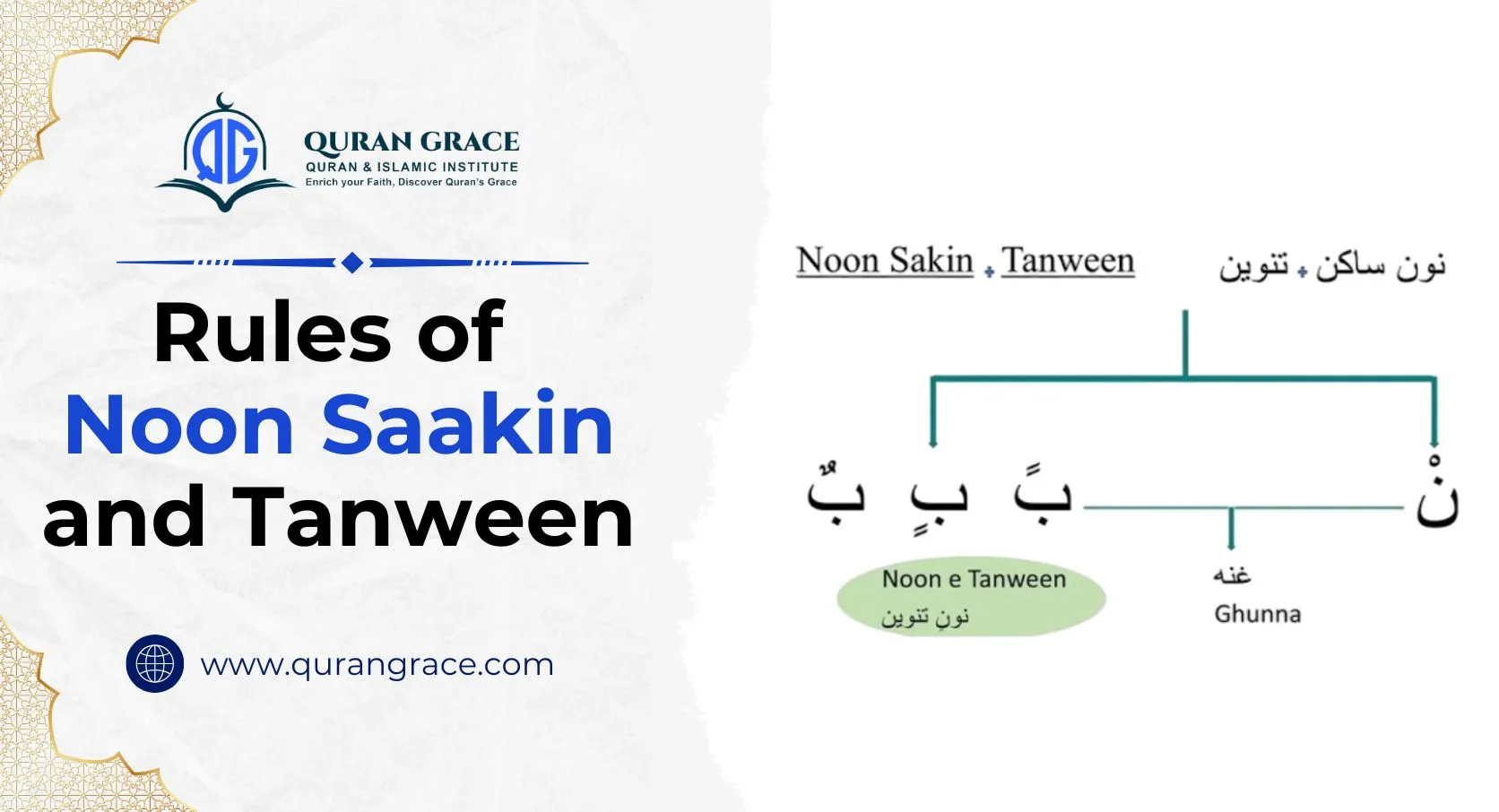The rules of Noon Saakin and Tanween are the 2 most important rules in Tajweed and hence control the core of Quran recitation. Noon Saakin and Tanween have 4 main rules. They include Izhar (clear pronunciation), Iqlaab (changing into a Meem sound), Idghaam (merging sounds with or without nasalization), and Ikhfaa (partial concealment). These rules ensure proper and melodic recitation of the Quran.
Table of Contents
ToggleWhat is Noon Saakin?
Noon Saakin refers to the Arabic letter “ن” (noon) when it carries a sukoon (ْ), meaning it has no vowel sound and is pronounced as “n.” There are specific rules governing its pronunciation, depending on the letter that follows it. These rules ensure proper Tajweed, maintaining Quranic recitation’s accuracy, rhythm, and fluency.
For instance, in the word “من” (min), which means “from,” the pronunciation of Noon Saakin changes based on the next word. Mastering these rules of reading the quran helps prevent mispronunciation, ensuring a smooth transition between words.
What is Tanween?
Tanween is the “n” sound added at the end of a noun or adjective in Arabic. It is represented by double vowel marks: double fathah (ً), double dhammah (ٌ), or double kasrah (ٍ). Unlike Noon Saakin, Tanween signifies indefiniteness and only appears at the end of words.
For example, in “كتابٌ” (kitaabun), meaning “a book,” the Tanween at the end creates a soft “n” sound. Tanween also plays a significant role in Quranic recitation, as its pronunciation varies depending on the letters that follow it.
Rules of Noon Saakin and Tanween
Here are 4 Rules of Noon Saakin and Tanweed With Examples from the Quran.
1- Idgham
Idgham means to merge one sound with the other. When a letter with a noon saakin (a diacritical mark that indicates the absence of a vowel sound) or tanween is followed by one of the letters “Ra,” “Meem,” “Waaw,” “Ya,” or “Nun,” Idgham will combine the noon sakinah or tanween sound with the subsequent letter. This is one of the Tajweed rules, and you can easily keep the letters of Idgham in mind as ‘YARMALON’ ( ي – ر- م – ل – و- ن ).
Idgham is divided into 2 types.
- Idgham with ghunnah
- Idgham without ghunnah.
1. Idgham With Ghunnah
This type of Idgham is used when the word after the noon saakin starts with one of the letters “Meem,” “Waaw,” “Ya,” or “Nun.” ( ي – م – و- ن ) In this case, the noon saakin is merged with the following letter, and the two letters are pronounced as one sound with a nasal sound (ghunnah).
For example, in the word “yawmaedhen yasduru” يَوْمَئِذٍ يَصْدُرُ (Al Zalzalah 6 ) the letter “ya ” follows the noon saakin. The noon and the “ya” are merged, and the word is pronounced as “yawmaedhey yasduru” with a nasal sound.
Instead of being pronounced separately, the noon sakinah or tanween sound will be silent in this case, and the letter that follows will be doubled. In other words, the noon sakinah or tanween sound is combined with the letter that follows.
Examples:
- يَوْمَئِذٍ يَصْدُرُ (Al Zalzalah 6)
- رَسُولٌۭ مِّنَ ٱللَّهِ يَتْلُوا۟ صُحُفًۭا مُّطَهَّرَةًۭ (Al Bayyebah 2)
- إِنَّ ٱلَّذِينَ كَفَرُوا۟ (Al Bayyenah 5)
To apply Idgham, one must have a thorough understanding of how sounds are combined and how the rule is applied in various situations. It is crucial to remember that using Idgham should not completely change the word’s pronunciation or meaning. You can easily learn the rules of Tajweed and master noon saakin and tanween in an online Tajweed course by Quran Grace.
2. Idgham Without Ghunnah
Idgham of this type is used when a word that comes after noon saakin begins with a letter other than “ra” or “lam” The following letter is combined with the noon saakin in this instance, and the two letters are pronounced as a single sound (ghunnah) devoid of any nasal sounds.
For instance, the letter “Ra” comes after the noon saakin in the word “abdan radeya.” The word “abadar radeya” is pronounced with a nasal sound, combining the noon and the “Ra.”
2- Izhar
Izhar in Tajweed refers to clearly pronouncing the Noon Sakinah or Tanween sound. It means to make it unambiguous.
The Arabic letters that are pronounced from the throat are known as the throat letters (حروف الحلق). Pronouncing these letters correctly takes a lot of work and energy. They are also referred to as the letters of Izhar.
Izhar letters or throat letters in Arabic are six letters
- ء (Hamzah)
- هـ (Haa)
- ع (Ain)
- ح (Ha)
- غ (Ghain)
- خ (Kha)
The throat letters are pronounced deep in the throat, and they require the mouth to be opened wide to produce the sound properly. The proper pronunciation of the Arabic throat letters is important in Tajweed, as it can significantly affect the meaning of words.
- The throat letters are also important in Tajweed because they interact with other Tajweed rules, such as the rules of Madd, Idgham, and Qalqalah. The proper application of these rules requires a precise understanding of the pronunciation of the throat letters and the diacritical marks that are used to indicate their pronunciation.
- Izhaar meaning Quran plays an important role in pronunciation. If Noon Saakinah appears before an Izhar letter, it should be pronounced clearly (openness).
Izhar in Quran: Surah Al-Fatihah contains one instance of “Izhar” in the text. In verse 4, the word “Iyyaka” (إِيَّاكَ) is spoken with “Izhar” as a distinct and clear “ya” sound rather than merging it with the sound that comes after it, “ka.” It is crucial to pronounce this word correctly with the sound “Izhar” since it sets it apart from other words with a similar sound and communicates the verse’s intended meaning.
Examples of izhar in Quran
- مِنْ أَحَدٍۢ (ankabut 28)
- بِعَذَابٍ أَلِيمٍ (luqman 7)
- بِٱلْمُؤْمِنِينَ مِنْ أَنفُسِهِمْ (Ahzab 6)
3- Iqlab
Iqlab means that if a Noon Saakinah or tanween appears before the letter Ba (ب) with a Fathah (ـَ) on it, the sound changes to Meem (م). An example of an iqlab letter is the word “men ba’d” which is pronounced, “mem ba’d,”.
In Tajweed, Iqlab is a rule of recitation that involves the pronunciation of the Arabic letter “noon” (ن) when it is followed by the Arabic letter “ba” (ب). The Iqlab rule requires that the sound of the letter “noon” is changed to a nasal sound that is similar to the sound of the letter “meem.”
The correct pronunciation of the Iqlab rule is crucial in Tajweed, as it can greatly impact the meanings of words in the Quran. The Iqlab rule is also connected to other Tajweed rules, such as those of Madd and Idgham. Applying these rules accurately requires a precise understanding of the pronunciation of Arabic letters and the diacritical marks that indicate how they are pronounced.
Iqlab examples from Quran
- عَلَىٰ مَا فَرَّطتُ فِى جَنۢبِ ٱللَّهِ( Al Zumar verse 56)
- كَلَّا ۖ لَيُنۢبَذَنَّ فِى ٱلْحُطَمَةِ (Al Humazah verse 4)
4- Ikhfa
In Tajweed, Ikhfa is a rule of recitation that involves the pronunciation of certain Arabic letters in a specific way. Ikhfa means “to conceal,” and the rule requires that the sound of the Arabic letter is pronounced in a way that is slightly concealed or muted.
There are 15 letters in Arabic language where we perform Ikhfa, and here they are : (ت – ث – ج – د – ذ – ز – س – ش – ص – ض – ط – ظ – ف – ك – ق)
When any of the specified letters appear after noon that is either silent or has tanween, the sound of the noon sakinah or tanween should be pronounced in a way that is slightly muted. While the sound is not completely hidden, it is pronounced less emphatically than it would be without the sakinah.
The proper application of the Ikhfa rule is crucial in Tajweed, as it can significantly affect the meaning of words in the Quran. This rule is also connected to other Tajweed rules, such as those governing Madd and Idgham. Mastering these rules requires a precise understanding of Arabic letter pronunciation and the diacritical marks that indicate how they should be pronounced.
Ikhfa examples from Quran
- (Al-Khaf: 43) (وَلَمْ تَكُن لَّهُۥ فِئَةٌ (يَنصُرُونَهُ)ۥ مِن دُونِ ٱللَّهِ وَمَا كَانَ (مُنتَصِرًا
- (An-Nisa: 71) يَٰٓأَيُّهَا ٱلَّذِينَ ءَامَنُوا۟ خُذُوا۟ حِذْرَكُمْ (فَٱنفِرُوا۟) ثُبَاتٍ أَوِ ٱنفِرُوا۟ جَمِيعًا
Conclusion
The Tajweed rules have an important role in Quran recitation. Tajweed is the science of proper pronunciation and recitation of the Quran, and it involves a set of rules and guidelines that help recite the Quran correctly and beautifully. You can join the free trial class at Quran Grace to efficiently learn the rules of noon sakin and tanween. Master the practical application of rules and recite the Quran like native Arabs. So, Join tajweed classes for adults, tajweed for children, and online tajweed classes for sisters to discover and develop your skills and enhance your quran learning today.








